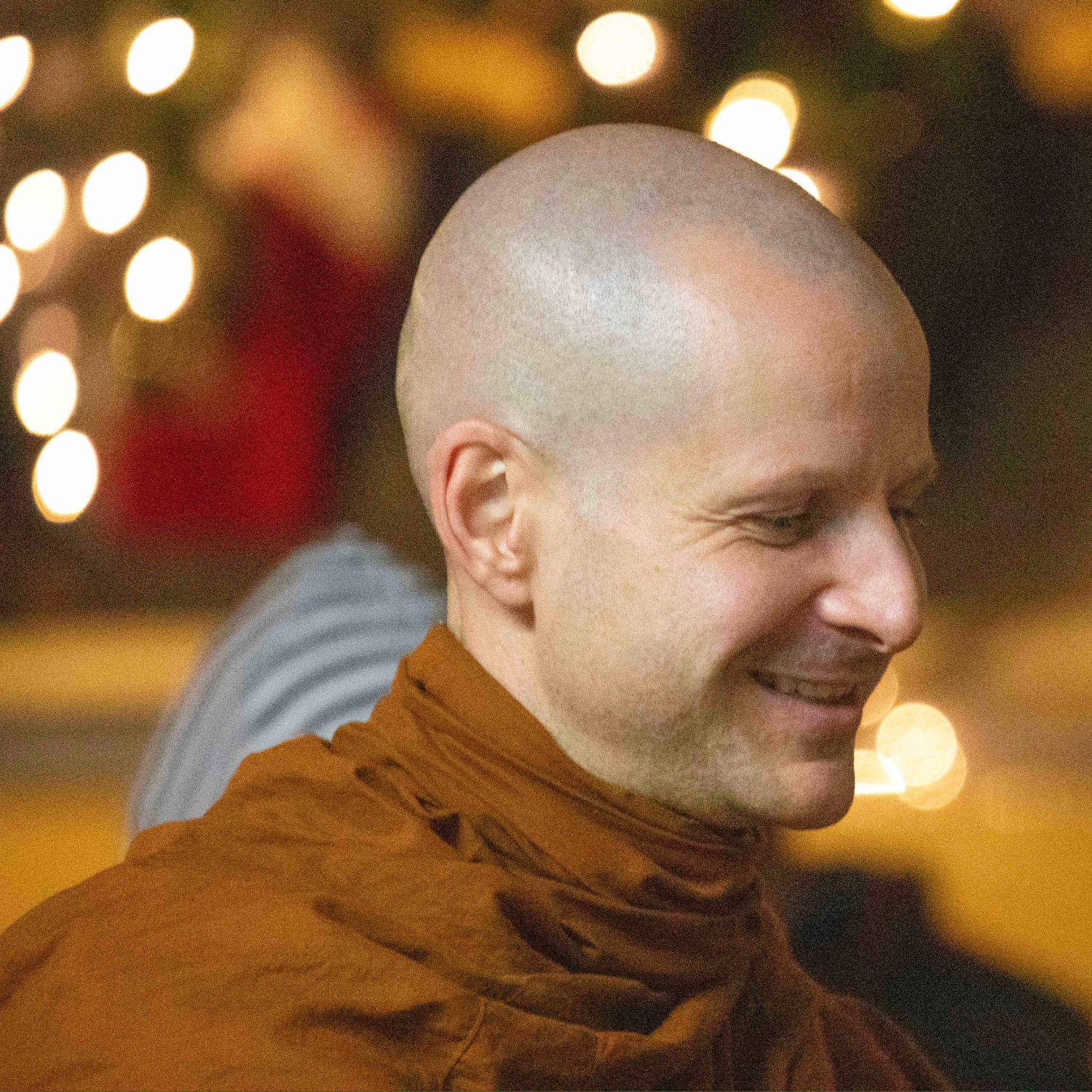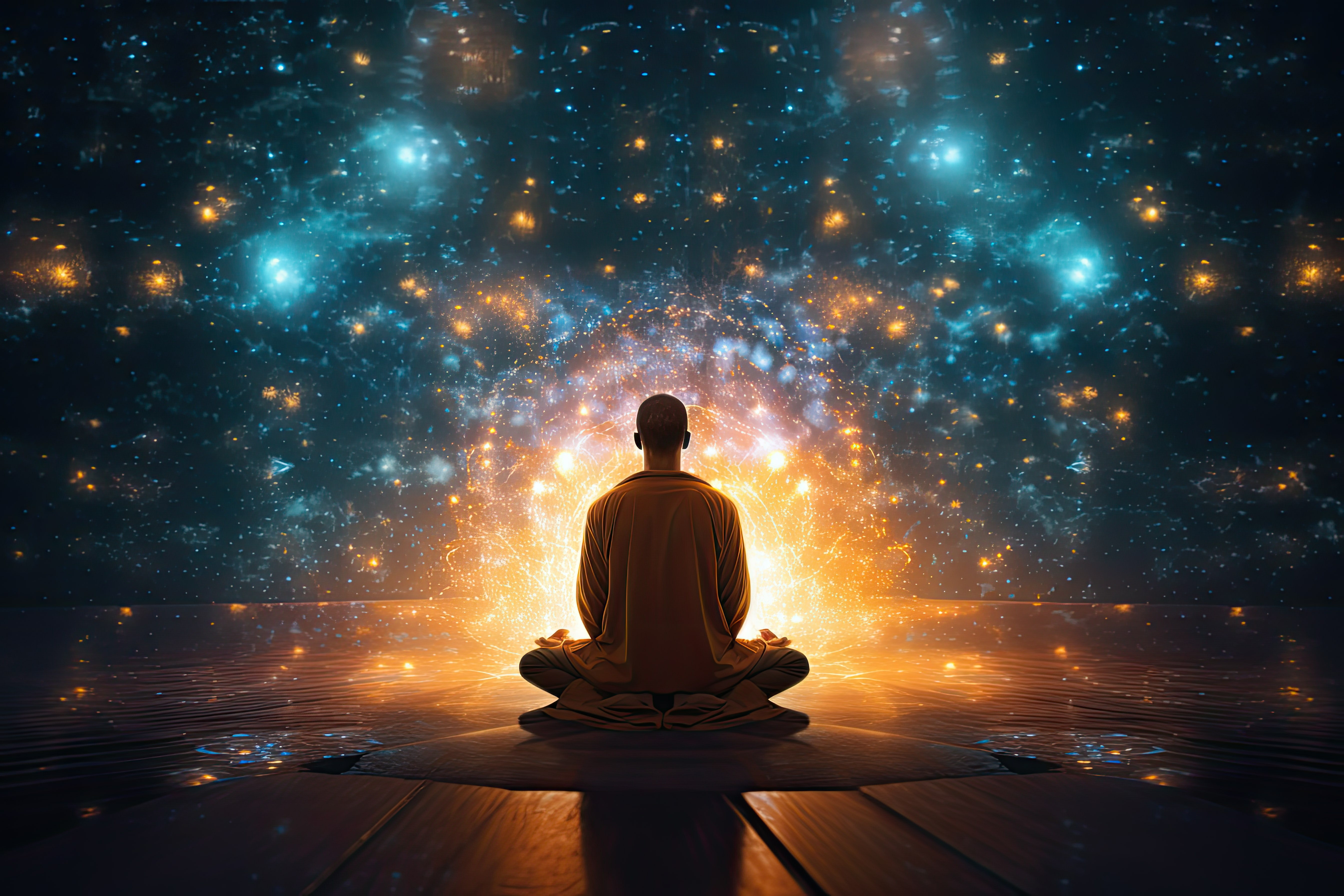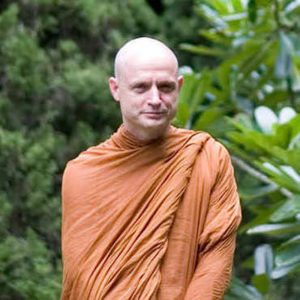
Ajahn Jayasaro: How Can the Buddha’s Teachings Inform Contemporary Education?
DRBU was fortunate to have Ajahn Jayasaro speak to the DRBU community on how the Buddha’s teachings can inform contemporary education. DRBU chaplain and instructor, Jin Chuan Shi, and DRBU BA student, Ajahn Kovilo, facilitated this Q&A session on education and being a student.
Dr. Susan Rounds, DRBU president, who has worked in K-12 as well as running a teacher education program for many years reflects on Ajahn Jayasaro’s sharing:
As someone who began her career in education as a kindergarten teacher, I was inspired to hear from Ajahn Jayasaro about his plan for infusing values into the education of young people. Although drawn from Buddhist ideals, the values are ones that children from any culture can relate to, and that any parent would be happy to have encouraged.
Ajahn Jayasaro was born on the island of Wright in England in 1958. After a pan Asian pilgrimage and hitchhiking through Europe, Ajahn Jayasaro joined a community in England as a monastic trainee. In late 1978, he traveled to Thailand to ordain at Ajahn Chah’s monastery and took full ordination with Ajahn Chah in 1980.
After years practicing at various monastic communities in Thailand, Ajahn Jayasaro took the position as the abbot of Wat Nanachat monastery, the largest international monastery for Theravada monks from 1992-2002. After ten years as the abbot, he returned to a more solitary mode of living and became more involved in Buddhist education. With passion and commitment, he maintained until this day as the direct spiritual advisor for various elementary and high schools. He is also the author of numerous books in both Thai and English, including the biography of Ajahn Chah and its English counterparts titled “Stillness Flowing”, which is part of the DRBU curriculum. In 2019 and 2020, Ajahn Jayasaro was honored with a series of royal monastic titles by the king of Thailand. In March of last year, he was granted the Thai citizenship by royal decree.
Ajahn Jayasaro currently lives alone in hermitage, about 100 miles away from Bangkok and has further established four additional hermitages. He teaches weekly at a nearby high school and bi-weekly at a Buddhist elementary school and at the meditation center, Babylon.
Transcript has been edited for clarity. Full video recording is available here.
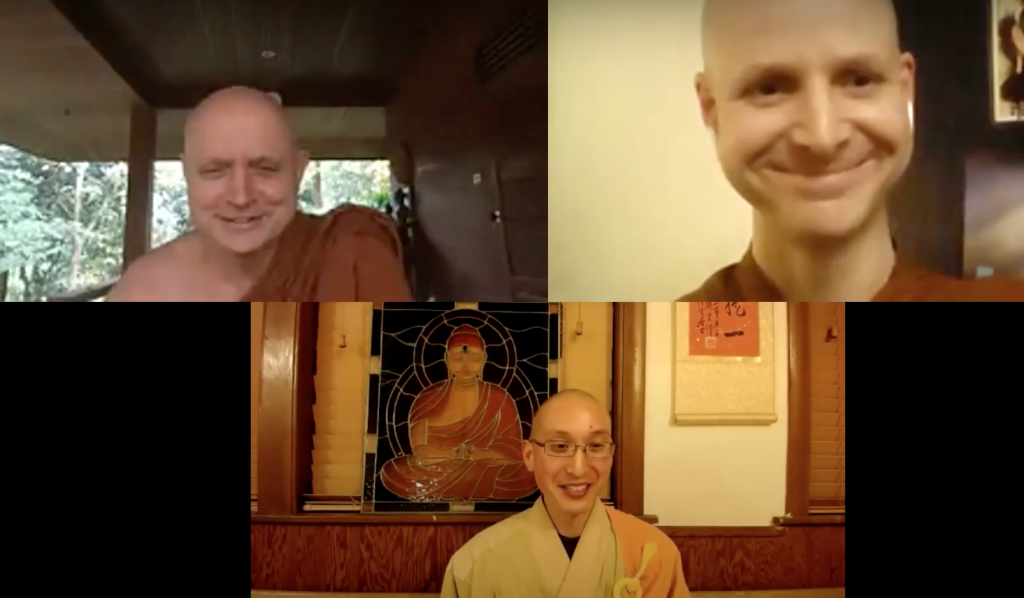
Jin Chuan Shi: Good Morning Ajahn Jayasaro! I first want to say that I deeply appreciate you taking the time to meet with us. I’m quite inspired by your talks and writings, especially the biography of Ajahn Chah, Stillness Flowing. To get the conversation started, would you be willing to share with us how you began working in education as a Buddhist monk?
Ajahn Jayasaro: Given that our time and energy is limited and there is only so much that we can do in any kind of productive way, education is what has always been at the heart of my life. A real turning point of my studying and understanding of dharma was coming to the conviction that the Buddha’s teachings are essentially the most profound comprehensive and effective education system that the world has ever seen.
I found that it is a shame that there’d been very few attempts to try to integrate the Buddhist visions and techniques of education of the whole human being with the government and private sector education in Thailand. It seemed like such a huge opportunity was being wasted.
From my early years in Thailand, I felt disappointment in how little Buddhist thought and Buddhist wisdom was coming to play in the development of society and economy. So, this is something I’d wanted to play a part in trying to remedy.
Some years ago, a student of mine, who was the head of a kindergarten school and had also opened a primary school, was disillusioned with what she could offer. So, that’s when we started getting together to talk about trying to develop the school along more Buddhist lines and applying more Buddhist principles. That was practically speaking my first direct involvement with Tawsi elementary school in Bangkok. Some years later, we developed a high school and a boarding school, which is just down the road from where I live now.
Jin Chuan Shi: That is wonderful to hear. Ajahn Jayasaro, would you be willing to talk about the twelve wise habits and the four areas of development? I was looking online at the Panyaden website and found, interestingly, that these twelve wise habits are Buddhist virtues: using the senses wisely, knowing the right amount, etc. I wonder if you are willing to share a little bit about that with everyone.
Ajahn Jayasaro: In fact, the inspiration, to some degree, came from a visit to America. We thought it would be a good idea to see what was going on in other parts of the world, not necessarily just Buddhist education, although we did come to the City of Ten Thousand Buddhas as part of this trip, but we also looked at a number of alternative schools.
One common theme that impressed me was that they would have a list of virtues or ideals, which were prominently displayed and were on everyone’s lips. In terms of creating a culture for a school or institution, I thought this was a very skillful way to do it.
On return from America, I applied myself by going through many suttas and from them culling what I deem to be virtues and specifically applicable to a non-monastic situation. Ones that would be useful, both for education in the school itself and for children to apply in their adult lives. So, these are taken from some of the key teachings of pāramīs or what we call the iddhi-pādā, the four roads to success. It is of course not an exhaustive list of Buddhist virtues, but I thought, once it gets over a dozen then it becomes too unwieldy and difficult to use as a means of recollection and as something which can guide the culture of an institution. So, I set the limit at twelve. There are some obvious absences such as gratitude and I thought many times, should I have put that into the group? But, as I say, you have to draw the line somewhere and it’s not that we don’t teach gratitude and filial piety, but they just aren’t included in that list.
Jin Chuan Shi: Will you be willing to explain the list? I saw there’s the physical, the social, the emotional, and the intellectual.
Ajahn Jayasaro: Maybe I should go into this first, what we call the four bhāvana (physical, social, emotional, intellectual), or areas of cultivation or education.
One of the difficulties we had during the early days, that you might find surprising, was that it was quite a revolutionary concept to adapt an education system to be in line with Buddhist principles. And particularly, we were working with an urban audience, and these days, people in Bangkok are quite secular in many ways.
One thing I’ve observed is that those who have had a Western education or have been influenced by Western culture, which I guess is everybody these days, tend to look at Buddhism through Western eyes and through Western ideas of what a religion is. And so, the idea is that there is a thing called religion and that all religions share a common feature in that they are essentially a belief system. 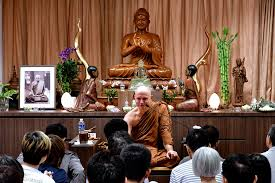
The counter idea that I’ve been promoting in the past many years is that religion can be divided into groups, or families, of religions and that Buddhism isn’t a member of the belief system family of religions. It shouldn’t be referred to as a belief system or a faith. It is a different kind of religion. It is an education system religion.
So looking at an education system religion as a belief system religion leads to distortion and all kinds of difficulties. Most people were looking at Buddhism as a belief system religion and assuming that a Buddhist school would essentially be replicating Catholic schools, simply substituting buddharupas or statues with crucifixes and so on.
I had to try to explain this in a way that could be understood by people who are not practitioners of the Dhamma, but are more culturally Buddhist. The monk who I look to as a teacher or mentor these days is Tan Somdet P.A. Payutto. He’s the trailblazer in this whole area and has written a number of books, mostly in Thai language, on Buddhist education. His idea was to base it on the threefold training, sīla, samādhi, paññā, which I think is correct and I follow it. The threefold training is just telescoping the eightfold path into three areas of study or training. But to use that as a framework for an education system for children who are not training to become monks and nuns is somewhat off putting. Many people worry that this training will develop children who are good and pure and kind, but are completely unprepared for the dog-eats-dog, big fish eats small fish, cut-throat world, in which they believe they live in. I won’t go into that. That’s a whole different kind of conversation. But, I found it would be better to try and find a different way to talk about the same thing. So I looked through the suttas and came across this teaching on the four bhavanas, which is really the threefold training (sīla, samādhi, paññā [wisdom]) in slightly different terms.
Sīla is divided into two. It’s the cultivation of the human relation with the material world and, secondly, the human relation with the social world. So it’s still action of body and speech but divided according to whether the object is in the material or social world.
Samādhi is referred to as citta, or the heart, and so it’s makes it much easier to talk about emotional quotient (EQ) or emotional development. The use of the word samādhi tends to be misleading and people think that it’s just a matter of sitting with your eyes closed, and going into refined states of consciousness. So, it’s really just changing the words, or the branding, if you like.
There are four areas: education of the human or the child’s relationship to the (1) material world and the (2) social world, (3) development of the heart and the mind, thoughts, and emotions, and (4) development of wisdom.
Coming back to the twelve wise habits, there is some overlap with the four bhāvanas. So for the first of the bhāvanas, human relationship to the material world, the two most prominent of the twelve wise habits, is taking care of the senses. In Buddhist texts it is often referred to as sense restraint. I didn’t want to present it in this ‘sense restraint’ way because it can be easily misunderstood. But it’s basically saying that we live in a confusing world, where we’re getting all kinds of information coming through our eyes, nose, tongue, body, and mind. It’s about being mindfully aware of and careful of what we allow into our hearts and our lives by mean of the senses. It’s taking an interest in what is going on in our eyes, nose, tongue, body, and mind. 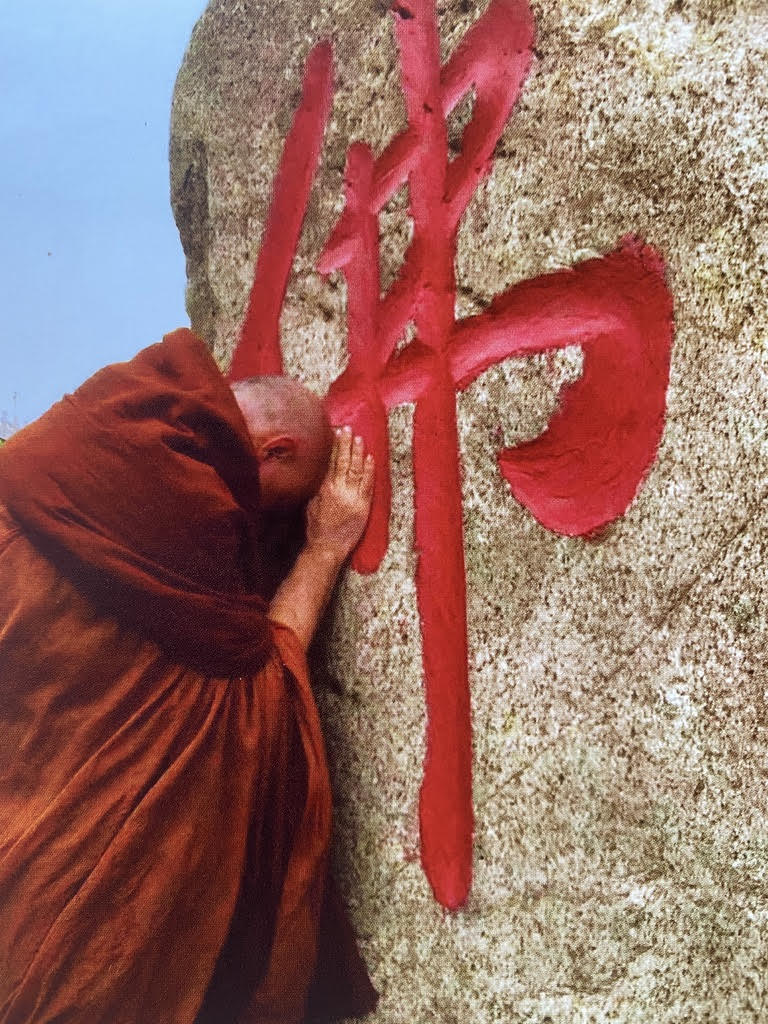
The second, mattaññutā, is knowing moderation or the right amount, and having some sense of questioning our relationship to technology and to all aspects of the material world with a sense of how much is enough. How much is the optimum?
On the social side, the first is non-harming, avihiṃsa. Non-harming is merely sīla. It’s how we relate to the people around us, using precepts and recollection of precepts as pegs and supports for mindfulness in our relation to the people around us. The key or the essence of sīla is not harming oneself or others.
The next one is cāga, or generosity, developing that generous heart and wishing to help and to support those around us.
In terms of education, chanda is central. This is enthusiasm, interest, and passion in regards to study and one’s life in general, and developing that ability of knowing how to inspire and uplift yourself when you feel down and discouraged. So, it’s learning the skills of instilling, promoting, and taking care of intrinsic motivation.
Khanti is patience, endurance, or forbearance. The Buddha said that it is the supreme incinerator of defilements and absolutely fundamental to success in any endeavor, worldly or spiritual.
Then there’s vīrya, or perseverance. I was recently speaking to the teachers at the kindergarten and primary school, and saying that I think maybe we are stressing the soft or the more passive kind of virtues and that’s how Buddhist virtues are generally characterized, but I would like to see an emphasis on this more active side, in particular on vīrya, or perseverance. And so whenever there’s some difficult thing coming up in the school, developing a kind of slogan for the kids: “We are Buddhists. We never give up!” Something like this. “What are we going to do about this? This seems difficult.” “Well! We are Buddhists, we never give up! We just keep going to the end.” Instilling this in children from three, four, five years old, so it becomes part of their identity as a Buddhist. It’s not like, “I’m a Buddhist. I’m cool. I don’t lose my temper. I’m kind.” That’s great, but also, “I’m a Buddhist. When I set my sight on something, I never give up. I just keep going. I’m tough.” In isolation, it might be a bit macho, but it’s within the whole context of those softer, warmer, kinder virtues.
Then, there are the brahmavihāras as the basic emotional orientation towards the world around us. Knowing when metta is appropriate, compassion, or karuṇā, is appropriate, sympathetic joy is appropriate, and equanimity is appropriate.
And then sati, of course. I probably don’t need to say much about mindfulness. It’s obviously super important everywhere. It’s like the prime minister in every area of the government, or like salt in every dish. Mindfulness present everywhere.
Is that everything, Ajahn Kovilo? Are you keeping track?
Ajahn Kovilo: Did you go over yoniso-manasikāra?
Ajahn Jayasaro: That is in the wisdom. Yoniso-manasikāra is thinking skill, basically wise thinking. In the Buddhist context, we divide it into two kinds. The kind of thinking which is aimed at reducing or eliminating unwholesome dhammas and promoting wholesome dhammas. For instance, if you’re very angry, then thinking about the good qualities of somebody in order to counteract the angry, unkind, and cruel thoughts. And then there’s thinking aimed specifically at the way things are. For instance, the reflection on how there’s nothing sure and what arises passes away. Investigating and thinking about, impermanence, anattā, and dukkha. In the school system, it starts off with basic good healthy thinking skills, critical thinking skills, creative thinking skills, and so on. One of the things you should look to gain from your education is the ability to think well.
Jin Chuan Shi: Wow! That is super comprehensive. I feel like I’d want to have gone to your school when I was growing up.
The last question I’d like to ask is something that I think is very important to our community at DRBU. It’s something we call ethical sensibility, developing this kind of inner sense of what’s skillful versus what’s unskillful. In Buddhism, it’s hiri-ottappa. I think you’ve translated it as ‘wise shame’ and ‘wise fear’. In our tradition, we’re still working on our translation. It’s often translated from the Chinese of 慚愧(cán kuì) to shame and remorse. But a lot of people don’t want shame and remorse.
Could you speak a little bit about that ethical sensibility or how a school would nurture that? It’s something we’re really wrestling on—how do we help develop it in the classroom and in our campus life and community?
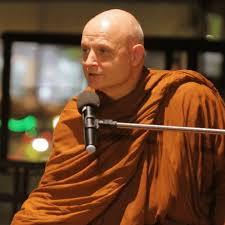 Ajahn Jayasaro: I prefer to put this prefix of ‘wise’ for skillful, shame, and fear, although, as you know, they’re not present in the Pali, Sanskrit, or Chinese. As you say, I think particularly in Western world, there’s so much confusion about what these words refer to, particularly in distinguishing between shame and guilt. It’s a real challenge in America and in a way that it’s maybe not necessarily the case here in Thailand.
Ajahn Jayasaro: I prefer to put this prefix of ‘wise’ for skillful, shame, and fear, although, as you know, they’re not present in the Pali, Sanskrit, or Chinese. As you say, I think particularly in Western world, there’s so much confusion about what these words refer to, particularly in distinguishing between shame and guilt. It’s a real challenge in America and in a way that it’s maybe not necessarily the case here in Thailand.
My view is that ethics and good, kind, thoughtful behavior, is just common sense and that the clearer you see things and the more you understand life, then the better you behave. I’m not in favor of saying: “you should feel ashamed of yourself” or “you shouldn’t feel ashamed”. I don’t think ‘shoulds’ and ‘shouldn’ts’ work very well. People either turn into sheep or else they become rebels. They don’t become good students.
I am interested in encouraging people to see that if you ask questions about what does it mean to be a human being, or a good son or a good daughter, a good husband or good wife, a good father or a good mother, or a good citizen, what do you think would be appropriate behavior to fulfill those kinds of ideas? Ideas, which are not being foisted upon you, but that you’re asked to come up with yourself. The more you have a clear idea of good, admirable, and inspiring behavior, and the more it’s right in the forefront of your mind, when you are in a situation where you are making ethical or moral choices, then that reflection pops up into your mind.
Hiri-ottappa are called guardians, because they question or they counter and they say “Oy, who goes there! That’s in conflict with the goals that you aspire to and your values. Are you sure you want to act in a way which is betraying your values?” I think if that occurs, and you are betraying your values, then the feeling that arises is what we call shame. It’s a sense of inherent conflict between how you are planning to or are acting, and your values.
Regarding fear, it’s a rational and wise fear; it’s not a foolish fear. It’s the fear that comes from reflecting upon and going over cases from your own life or from people around you and the consequences of actions. The lack of fear is what we would call recklessness. When you are about to do something and maybe you have a prick conscience, saying “that’s not a good thing to do” and you tell it “shut up” and you just go into overdrive, that’s what the lack of fear means. Wise fear means you don’t shy away, censor, or turn your back on your awareness of the consequences of what you are doing. “Yes, this has consequences, and no, the consequences are not worth the pleasure you may get from acting in this way.”
Again, it’s your choice, but it’s basically “Yeah, I’m gonna get a small amount of pleasure from this. A limited, temporal pleasure. And then I’m going to have to face some very unpleasant consequences. It’s not worth it!” This fear of what happens is that wise fear.
In summary, reflecting wisely, or yoniso-manasikāra, on your values, and on the consequences of actions, when put in the position where you are pressured or tempted to act in unethical ways, these things spring to mind and they come to bear upon your decisions.
Jin Chuan Shi: Wonderful! Ajahn Kovilo, would you like to ask a few questions?
Ajahn Kovilo: One question which came to mind is that among those twelve wise habits, there is a quality of knowing the right amount. I’m curious if you’d be able to say anything about how to discern the right amount in regard to the three areas, maybe specifically thinking about students— how to know the right amount in regards to sleep, to study time, and to meditation or spiritual cultivation. How to balance that?
Ajahn Jayasaro: First of all, I don’t think there is an answer we can come to and say, “Now I’ve got this worked out! For me, so many hours of sleep and so many hours of this and that’s it, I don’t have to think about it anymore.” Because it’s a dynamic thing and it can change from day to day or from month to month, according to things like physical health, workload, and all kinds of other factors. It is a contingent thing that you are constantly having to reassess. It’s not just something you can say, “Yeah, I got that one worked out.”
As far as the right amount, I think it’s important to recognize that the criteria that you need to make that kind of call appears when you are clear about your goal. Let’s say in spiritual life, in the eightfold path or the practice of dharma, what is the right amount of doing that which is leading you onward to the goal?
Let’s say your goal is abandonment of greed, hatred, and delusion. And you get very lazy for a period and you are not practicing as much. You realize that it is the case and then you might apply a short-term correction, by doing an all night sit or doing something that goes against the grain. An outward observer might say, “That can’t be the middle way! That can’t be the right amount! That is just way over the top! That is tormenting yourself!” But, from the perspective of the overall practice on the path to nibbāna, a short-term correction may well be needed. It’s not the way of practice that will take you all the way, but when you are straying off the path to the left, as Ajahn Chah would say, you have to move to the right, even though moving to the right isn’t necessarily the direction that you want to go. Everything has to be related to the goal. How does this particular practice relate to the lessening and abandoning of unwholesome dharmas and the cultivation and development of wholesome dharmas.
The simile that Ajahn Chah gave, which I found very helpful, is that it is as if we are rowing a boat across a very swiftly flowing river. If you’re an experienced oarsman you know that you shouldn’t set your goal at the jetty directly facing you, but you should point your boat upstream a little, allowing the strength of the current to correct the course and allow you to cross straight over. Similarly, when we are involved in any kind of activity, in which defilement is involved, which is almost everything, then we go a little stricter than what is maybe the optimum, allowing for the corrective force, or the influence of the defilement. It’s a skillful means of dealing with defilements. If we go directly with what we feel would be just the right amount, then we’ll end up less than the right amount. So, we’re adding a little more than the right amount, assuming that it will, hopefully, end up with the right amount.
With school and academic work, it’s trial and error basically. I don’t think there’s any kind of general rule here. Time management skills are as important as spiritual skills. Learning with interest and learning from experience and not making the same mistake twice, if you can help it. Pushing a little bit, but knowing when to relax. There’s no fixed rhythm. Everyone’s different. It’s more that sense of getting a feel for balance. One of my favorite stories in regard to this is of the Aikido master and the student. The student says to the master: “Master, after all these years, I’ve never seen you losing your balance. It’s incredible!” The teacher replied: “Well, I lose my balance all the time but I regain my balance so quickly you don’t ever see it.” So, I think we all will lose balance but it’s the extent to which we are sensitive to that and re-establish balance and learn from it.
With sleep, I would say if you dream a lot, then that usually means you sleep too much particularly if you dream in the morning before you wake up. If you are falling asleep when you’re studying, it probably means you’re not getting enough sleep. If you wake up and are irritable and agitated, that is probably too much sleep. That would be my guess. I’m in favor of short naps during the day, for 5 or 10 minutes. We get up very early in Thailand and go to bed quite late at night. I find that if I have 15 minutes during the day, I feel really refreshed. But again, it depends on whether you can do that or not in a school or college situation.
Ajahn Kovilo: Thank you Ajahn. I have another question which is probably similarly not that easy to give cut and dry answers to, but, how about using the senses wisely and specifically with regards to internet use? As students we have to use the internet to do research and we’re living in places that have wifi 24 hours a day. Do you have any thoughts about how a practitioner can put boundaries around their internet use?
Ajahn Jayasaro: First of all, I just feel grateful for internet. We can speak today because of the internet. You’ve known me for many years now and how completely impractical I am in every area of the material world and having YouTube, there are all these kind people who post YouTube videos and tell you how to do things properly. So I am very grateful for the kindness and the dāna. This is the new field of dāna, isn’t it? YouTube. People putting things and sharing their knowledge about things.
But, the internet, it’s not just one world. It’s worlds upon worlds upon worlds…and wormholes. Probably the most simple thing is to have time limits and to keep a diary if you do find yourself wandering off into not so wholesome or helpful areas of the internet. Keeping a diary being very honest about where you’ve been and for how long is helpful.
In terms of dhamma practice, we have wholesome and unwholesome dharmas as our basic go-to and these things are increasing the unwholesome dharmas, whether these are laziness or a distracted mind.
In terms of a test, if our mind is in an unwholesome state then the idea of meditating is really unattractive, rather off-putting. So if you think, “maybe I’ll just go and meditate for half an hour or I’ll go and walk,” take a look and see how your immediate reaction to that is. And if it’s, “Nah. I’ve still got this to do and I’ve still got that to do” or “I don’t really feel like that,” then that is usually a sign that your mind is not in such a wholesome state.
It is central to all these areas of practice, that ability to tune into the mind, particularly in terms of whether the mind is wholesome or unwholesome, and the merit and demerit of the mind. There’s artificial restraints, such as time limits and keeping close records of how you spend time, and then the less measurable means of keeping very close tags on the wholesome or unwholesome state of the mind.
Ajahn Kovilo: Thank you, Ajahn. I have one more question. All of us are coming here to DRBU with a pretty strong intention of wanting to learn, but of course, school work can wear on you and people can get overloaded. I’m wondering if you have any thoughts about how to maintain or stoke the joy, basically associating learning with a joyful experience rather than being a chore.
Ajahn Jayasaro: I don’t think it is necessarily a choice between joy and drudgery. It is probably more practical to find somewhere in between those two. But if it’s a chore and drudgery, then there is always some vibhava-taṇhā, which is a technical term that means the desire not to be, not to have to do this, or that it’s not like this. Some things are not fun and you can’t be with a sense of joy and bliss all the time anyway. Sometimes, it’s just the matter of being patient and working away patiently.
What is very important is to prevent this negativity and negative thinking, “I don’t want to be like this. It shouldn’t be like this. I wish it were something else.” That’s all the ways that the mind struggles, opposes, and resists how things are like. It’s not so great fun, but it is what it is. You’ll remember, of course, the simile of the arrow and the poison on the arrow. Sometimes while studying, you get hit by an arrow but don’t go put any poison on the arrow.
In terms of bringing out more positive emotions, there’s the recollection of the goodness and kindness of teachers—how wonderful it is to have good friends, sharing the same values and the same pursuits, and bringing to mind all the goodness that surrounds us. I think muditā, empathetic joy, is such an undervalued practice. It is not like positive thinking like, “Oh yeah. Everything is wonderful.” But, looking and observing, whereas the news and the world that appears on our screen is eighty to ninety percent depressing, what goes on around us, particularly in the communities that we live in, is eighty to ninety percent not depressing! Quite the opposite. The more sensitive you become to goodness and kindness, then it’s just this constant drip, drip, drip of happiness. So just opening our eyes to all the goodness and kindness everyday. I’m not talking about the “wow” kind of generosity and nobility, but just on how we live together, how much we do for each other, and how wonderful that is. I think that’s something that can really uplift the mind.
